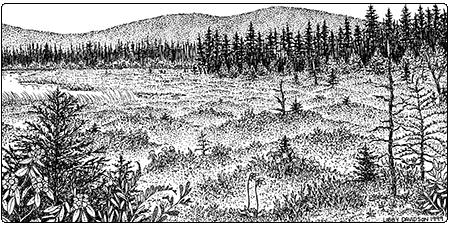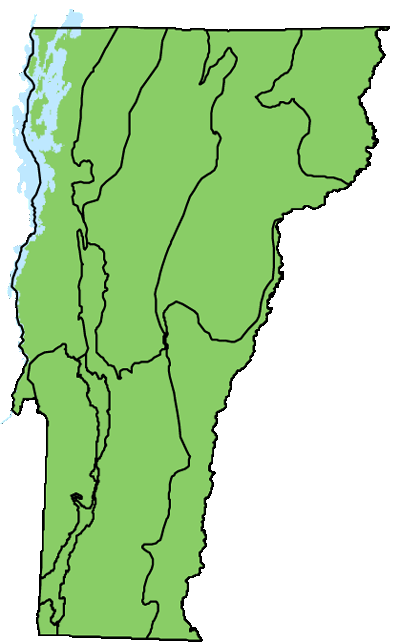Ecology and Physical Setting 
There is an otherworldly character to a bog that is unlike any other part of our Vermont landscape. Bogs are quiet places with soft, spongy ground underfoot, often with dense conifer forests surrounding them. They are open but may have a few scattered, stunted trees. Early summer brings a profusion of flowers on the low shrubs, and songs of birds commonly found much farther north. Insectivorous pitcher plants and sundews—well adapted to the low nutrient environments of bogs—are common.
Dwarf Shrub Bogs are open peatlands with acidic water (pH of 3.5 to 5.0) that is very low in dissolved minerals and nutrients. Bogs are considered ombrotrophic if they receive water and nutrients only from precipitation. Ombrotrophic bogs have a raised peat surface and a water table that generally remains just below the surface but is elevated above the local water table of surrounding wetlands or uplands. The permanently saturated, acidic conditions severely limit decomposition in bogs, resulting in significant accumulation of poorly decomposed sphagnum peat. Dwarf Shrub Bogs have well-developed microtopography, with tall hummocks and moist hollows.

Across boreal regions, bogs and other peatland types cover extensive areas of the landscape. Bogs in Vermont are relatively small; only Maquam Bog and Peacham Bog are greater than 100 acres. Many bogs occur as inclusions in larger wetland complexes, or occasionally in kettlehole basins. In cases where bogs occur as part of larger wetland systems, they are typically found in central portions of the complex where peat has developed to sufficient depth to effectively isolate the bog surface from the influence of mineral-rich ground or surface water. Kettlehole basins are depressions left in the ground from partially buried ice blocks that melted after the retreat of the glaciers. In these settings there is commonly a floating bog mat over open water in the center of the basin.
Dwarf Shrub Bogs commonly grade into Black Spruce Woodland Bogs, which in turn may grade into Black Spruce Swamps. Dwarf Shrub Bogs may also grade into Poor Fens in areas where there is adjacent open water or some seepage of mineral-enriched groundwater. When occurring in basins surrounded by upland forests, Dwarf Shrub Bogs are typically bordered by a narrow, wet, tall shrub-dominated strip known as a lagg or moat. Water accumulates in this lagg as a result of drainage from the surrounding uplands and the slightly raised surface of the bog. The water in the lagg may be stagnant or slowly moving, but it is enriched with dissolved minerals compared to the open bog.
Vegetation
The dominant vegetation of bogs is sphagnum moss, which forms a continuous carpet over hummocks and hollows, and provides a substrate for other plants. In many cases, trees and tall shrubs are sparse or nearly absent. Dwarf shrubs are common. Sedges are also common and grow both on hummocks and in hollows.
Many species of sphagnum moss can occur in any one bog, but there are distinct, easily observed patterns to the distribution of these species. One such pattern can be observed in the species zonation that occurs from dry hummock tops to the moist hollow bottoms two to three feet below. The brown-colored Sphagnum fuscum dominates hummock tops, with a progression down the hummock sides of Sphagnum capillifolium, Sphagnum magellanicum, Sphagnum angustifolium, and Sphagnum fallax. Sphagnum cuspidatum occurs in the wetter hollows with some standing water.
Low heath shrubs dominate the hummocks—common species include leatherleaf, bog laurel, Labrador tea, sheep laurel, and bog rosemary. Low plants of the hummocks include small cranberry, Billings’ sedge, few-flowered sedge, and hare’s tail cottongrass. Pitcher plant and round-leaved sundew are also common. On hummocks there may be scattered, stunted black spruce and tamarack trees. Lichens may also be common.

Wildlife Habitat
Dwarf Shrub Bogs provide habitat for a surprising number of wildlife species. Masked shrew and the rare southern bog lemming both prefer moist habitats like Dwarf Shrub Bogs. Lincoln’s sparrow is a boreal species that also breeds in shrubby peatlands, primarily in the Northeastern Highlands. White-throated sparrows and common yellowthroats also breed in open bogs. The shy American black duck nests in bogs with open ponds, as does the rare ring-necked duck—a diving duck of the far north. Northern harriers build their nests on hummocks in expansive Dwarf Shrub Bogs and other open wetlands.
Several species of rare butterflies are associated with Dwarf Shrub Bogs. One, the small bog copper, is a poor flier and may spend its entire life in a single bog, with the adult feeding on nectar from heath shrubs and the caterpillar feeding exclusively on cranberries. Caterpillars of the brown elfin, another rare butterfly, feed on a variety of bog heath shrubs.
There are a surprising number of dragonflies and damselflies that are closely associated with acidic peatlands like Dwarf Shrub Bogs. Although the life cycles of these odonates vary considerably, many share a common habitat preference for bog pools and saturated sphagnum moss. The Hudsonian whiteface is widespread in Vermont’s bogs and fens, and it is one of the earliest to take flight, often in April. The rare delicate emerald, a dragonfly more common to the north, is found in peatlands of the Nulhegan Basin. Uncommon in Vermont, the beautiful sphagnum sprite damselfly is mostly restricted to bogs and fens with sphagnum moss.
Related Communities
- Black Spruce Woodland Bog has an open, stunted canopy (25 to 60 percent cover) dominated by black spruce, with abundant heath shrubs and sphagnum moss. Dwarf Shrub Bogs often grade into Black Spruce Woodland Bogs.
- Poor Fens receive slight mineral enrichment from groundwater seepage or association with the open water of ponds. Sphagnum mosses and heath shrubs are common, as are indicators of mineral input like like mud sedge, white beakrush, and bog-bean.
Conservation Status and Management Considerations
Dwarf Shrub Bogs are considered rare in Vermont, both because there are relatively few known sites and because the total acreage is low. There are, however, several high-quality examples protected on land owned by the public or by conservation organizations. The integrity of bogs can be threatened by significant changes in adjacent land use that result in increases in runoff and changes in water quality, such as development and clear-cutting. Dwarf Shrub Bogs are also susceptible to trampling and compaction from heavy human use. Boardwalks can help visitors experience bogs with minimal disturbance to the vegetation.
Distribution/Abundance 
Dwarf shrub bogs occur throughout Vermont but are more common in the cooler regions of the state. Similar communities are found throughout the Northeast, Midwest, and adjacent Canada.
Characteristic Plants
Trees (stunted)
Occasional to Locally Abundant Species
Black spruce – Picea mariana
Tamarack – Larix laricina
Shrubs
Abundant Species
Leatherleaf – Chamaedaphne calyculata
Bog laurel – Kalmia polifolia
Small cranberry – Vaccinium oxycoccos
Occasional to Locally Abundant Species
Labrador tea – Rhododendron groenlandicum
Sheep laurel – Kalmia angustifolia
Bog rosemary – Andromeda polifolia
Black chokeberry – Aronia melanocarpa
Herbs
Occasional to Locally Abundant Species
Billings’ sedge – Carex billingsii
Few-flowered sedge – Carex pauciflora
Hare’s tail cottongrass – Eriophorum vaginatum
Pitcher plant – Sarracenia purpurea
Round-leaved sundew – Drosera rotundifolia
Few-seeded sedge – Carex oligosperma
Three-leaved false Solomon’s seal – Maianthemum trifolium
Bryophytes
Abundant Species
Moss – Sphagnum fuscum
Moss – Sphagnum capillifolium
Moss – Sphagnum magellanicum
Occasional to Locally Abundant Species
Moss – Sphagnum angustifolium
Moss – Sphagnum fallax
Moss – Sphagnum cuspidatum
Bog broom moss – Dicranum undulatum
Bog haircap moss – Polytrichum strictum
Liverwort – Mylia anomala
Rare and Uncommon Plants
White fringed orchis – Platanthera blephariglottis
Bog sedge – Carex exilis
Bog aster – Oclemena nemoralis
Michaux’s sedge – Carex michauxiana
Few-seeded sedge – Carex oligosperma
Dwarf mistletoe – Arceuthobium pusillum
Hidden-flowered bladderwort – Utricularia geminiscapa
Southern twayblade – Neottia bifolia
Associated Animals
Masked shrew – Sorex cinereus
White-throated sparrow – Zonotrichia albicollis
Lincoln’s sparrow – Melospiza lincolnii
Common yellowthroat – Geothlypis trichas
Mallard – Anas platyrhynchos
Brush-tipped emerald – Somatochlora walshii
Clamp-tipped emerald – Somatochlora tenebrosa
Canada darner – Aeshna canadensis
Hudsonian whiteface – Leucorrhinia hudsonica
Frosted whiteface – Leucorrhinia frigida
Belted whiteface – Leucorrhinia proxima
Rare and Uncommon Animals
Four-toed salamander – Hemidactylium scutatum
Smooth greensnake – Opheodrys vernalis
Southern bog lemming – Synaptomys cooperi
Ring-necked duck – Aythya collaris
American black duck – Anas rubripes
Northern harrier – Circus hudsonicus
Rusty blackbird – Euphagus carolinus
Bog copper – Lycaena epixanthe
Brown elfin – Callophrys augustinus
Jutta arctic – Oeneis jutta
Two-spotted skipper – Euphyes bimacula
Kennedy’s emerald – Somatochlora kennedyi
Forcipate emerald – Somatochlora forcipata
Delicate emerald – Somatochlora franklini
Sphagnum sprite – Nehalennia gracilis
Subarctic darner – Aeshna subarctica
Harlequin darner – Gomphaeschna furcillata
Places to Visit
Moose Bog, Wenlock Wildlife Management Area, Ferdinand, Vermont Fish and Wildlife Department
Maquam Bog, Missisquoi National Wildlife Refuge, Swanton, U.S. Fish and Wildlife Service
Peacham Bog, Groton State Forest, Peacham, Vermont Department of Forests, Parks, and Recreation
